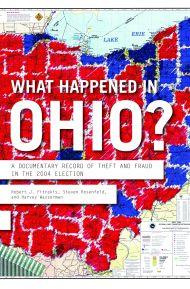by Bob Fitrakis & Harvey Wasserman
March 23, 2007
Breaking news in vote fraud cases in both Ohio and Florida are feeding a firestorm of controversy that is likely to continue escalating, with major implications for the 2008 election and the future of e-voting machines.
In Ohio, Jennifer Brunner, the newly elected Secretary of State, has received two of the four resignations she requested from the Cuyahoga County Board of Elections (BOE). The two Democrats on the Board, Edward Coaxum, Jr. and Loree Soggs, have complied with her call for their departures from Cleveland’s scandal-ridden election authority.
However, Robert Bennett, who chairs both the Cuyahoga BOE and the Ohio Republican Party, has thus far refused Brunner’s request. So has Sally Florkiewicz, Bennett’s fellow Republican on the BOE. Should they continue with their refusal to resign, Brunner has threatened to hold public hearings, in the wake of which she could force the resignations.
Meanwhile, the Associated Press reports that a criminal investigation is underway which centers on the Cuyahoga BOE’s conduct of the November 2006 election. Cuyahoga County Prosecutor Bill Mason has turned again to Erie County Prosecutor Kevin Baxter who recently won felony convictions of two BOE workers for rigging the 2004 presidential recount for another criminal investigation. Baxter will be investigating “possible criminal wrongdoings” related to ballot security and the scanning of absentee ballots.
A Cleveland State University Center for Election Integrity study has exposed various election irregularities in Cuyahoga County in the 2006 election. Among the most egregious were the BOE’s failure to secure the dual keys (one for the Dems and one for the Republicans) required for the vote counting rooms; that they allowed shared computer passwords; and that they allowed an unexplained cable connection to the county’s vote counting computer.
The Free Press also has viewed a video shot by Jeff Kirkby showing Cuyahoga County election workers downloading the county’s election data onto portable laptops that were allegedly allowed to go home with BOE employees. These practices raise serious concerns over election data security.
Massive computer failures during the May 2006 primary led in February 2007 to the resignation of Michael Vu, who was the executive director of the Cuyahoga BOE at the time. Both Bennett and Vu pushed for the $20 million purchase of Diebold voting machines over strenuous objections from election protection activists, whose concerns were cablecast in the HBO documentary “Hacking Democracy” shown nationwide just prior to the November 2006 election.
On March 21, the Dayton Daily News reported that “After two days of tests, the results are in: About 2,500 people cast ballots in November on 56 malfunctioning electronic touch-screen voting machines in Montgomery County, said Steve Harsman, county board of elections director.”
The Free Press has previously reported that there were nearly 30,000 undervotes in Montgomery County during the 2006 gubernatorial race, meaning an abnormally high 13.67% of all voters reportedly recorded no vote for the state’s highest office. (See chart posted with this article at the Freepress.org web site courtesy of Pete Johnson and CASE-Ohio) Similar undervote problems exist in Adams, Darke, Highland, Mercer and Perry counties.
Meanwhile, Jonathon Simon has informed the Free Press that the Election Defense Alliance (EDA) is analyzing data from Adams County as part of a project to compare exit polls to actual votes. In the 2004 election, the exit polls showed John Kerry winning, while the actual machine and computer tabulated results gave the state to Bush by 118,000 votes.
Meanwhile, in Florida, internal memos from the ES&S voting machine company indicate an e-voting machine created an undervote problem, according to Wired News. In Sarasota County, 18,000 ballots recorded no votes in a hotly contested congressional race.
“But the memo, which the company sent to Florida election officials before the state’s September primary, revealed that the iVotronic machines had a flaw that sometimes caused machines to respond slowly to a voter’s touch ‘beyond the normal time a voter would expect to have their selection highlighted.’ The memo stated that a software upgrade was required but couldn’t be certified before the September election. In its absence, ES&S sent election officials a warning sign to post at polls advising voters that they might need to press the screen for several seconds before their votes would register,” wrote Wired News.
Reginald Mitchell, lawyer for People for the American Way, told Wired News that “this memo is the smoking gun….”
The six counties under investigation in Ohio all used Diebold machines suggesting that both major suppliers of e-voting machines have similar flaws that create undervotes.
These waves of breaking news about serious problems in the conduct of the 2004 and 2006 elections, and in the performance of electronic voting machines in the two states that have decided the last two presidential elections, make it a virtual certainty that we have barely begun to see the full extent of what has really been done to the American democratic system.
—
Bob Fitrakis & Harvey Wasserman are co-authors of three books on the presidential election of 2004, and continue to cover breaking election protection issues at www.freepress.org.
Download the Excel spreadsheet.


 I haven’t blogged since the election, although there have been a few postings of articles I’ve written for the Free Press. But I break this unofficial vow of silence to mourn Molly Ivins, the longtime Free Press columnist and Pulitzer Prize-nominated writer.
I haven’t blogged since the election, although there have been a few postings of articles I’ve written for the Free Press. But I break this unofficial vow of silence to mourn Molly Ivins, the longtime Free Press columnist and Pulitzer Prize-nominated writer.